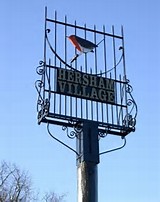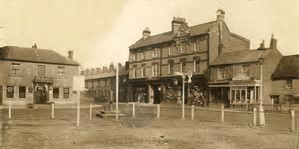Hersham is a Village, in the County of Surrey, England

In 1851 an Act of Parliament created Hersham as an Administrative Parish and District within its own right and set down in Law the boundaries of Hersham (reference National Archives Kew, London, England).
The 1851 Act stipulates that the Parish boundary lines are to the North The London and South Western Railway (Now called the Southwestern Main Line) to the East The River Mole and the River Mole forms boundary line all the way round to the Pump House at the back of Painshill Park (which has a postal address of Cobham) and therefore the River Mole also forms part of the Southern Boundary. The Southern Boundary then runs along a line to Byfleet Mill on the River Wey this line is the path of the M25. The Western boundary of Hersham is a straight line from Byfleet Mill through the middle of St Georges Hill (which has a Postal Address of Weybridge) to the railway line
Whilst over the years many administrative boundary lines have changed such as in 1933 when for administration reasons Hersham became part of Walton & Weybridge Urban District Council (UDC), and then again in 1969 with the formation of Elmbridge Borough Council, which was the uniting of Walton & Weybridge UDC and Esher & Molesey UDC. Throughout these changes Hersham has retained the boundary area set out in the 1851 Act.
In 2016 The Conservative Administration on Elmbridge Borough Council, made changes, (which were against the wishes of the residents) in order to reduce the number of elected Councillors, the result of this change resulted in Hersham being split into FIVE separate areas for administration purposes. THIS CHANGE IS ONLY APPLICABLE FOR THE AREAS OF ADMINISTRATION COVERED BY ELMBRIDGE BOROUGH COUNCIL ONLY, FOR PARISH, COUNTY COUNCIL AND CENTRAL GOVERNMENT ADMINISTRATION THE CHANGES MADE IN 2016 DO NOT APPLY
Hersham began as a strip of woodland beside the River Mole. It was occupied by pre-historic folk whose flint instruments have been found in large numbers beside the River on what is now Southwood Manor Farm. This dates mostly from the Mesolithic period.
Somewhere around 200 B.C. a huge defensive earthwork was erected on top of what is now St George's Hill, probably as a military camp against invaders coming up the Thames Valley.
The fact that this was constructed at all indicates a fairly large population in the district, a chieftain of some sort, organised labour and a desperate perhaps recurring danger. Bronze and Iron Age burials have been found on the slopes of the hill which was clearly a feature of some importance in ancient times.

The Anglo-Saxons may well have been the first permanent settlers here; they certainly gave the name to the place and no older remains of actual dwellings in areas not mentioned above have been found. In the 12th century it was written Haverichesham suggesting Haeferick's hamlet or river bend settlement. By contraction the name become Haverisham, Haversham, Harsham or Hersham before finally settling only on the latter.
Hersham's first chapel of ease (Holy Trinity church, which was demolished in 1889 having been superseded) was built of yellow brick in Anglo-Norman style in 1839. Similarly Congregationalists had a Round Chapel which existed from 1844 until 1961, the year in which the single dual carriageway in Hersham was created, and enabling its construction.
Moor Hall, Syklesmore or Southwood
Hersham contained one Manor alone known as Morehall alias Sylkesmore or Southwood. Mention of a Court held at Hersham in 1272 by Reginald de Imworth and Matilda his wife, indicate that he was then the Lord of the Manor.
When Henry VIII built Nonsuch Palace in Cheam as many as eighty loads of timber were obtained from Southwood, or the South Woods, for it. In 1540 he purchased from John Carleton the "Manor of Morehall or Sylkesmore" in Hersham, together with lands and woods in Burwood and Hatch in Hersham. The Manor remained in the possession of the Crown, and in 1554 was where Mary I of England and Prince Philip of Spain resided following their marriage. In 1579 Queen Elizabeth I granted to Thomas Vincent "the Manor, site, and demesne lands of Morehall, and the wood called Sylkesmore coppice". In the 18th century and until at least 1802, the estate, then known as 'the Manor of Southwood and Silksmore,' appears to have been held by the Frederick family. The estate is now known as Southwood Manor Farm
As a child Queen Victoria used to come to Hersham, and she saw her first Steam Traction Engine in use at The Manor of Southwood and Silksmore.
Other famous residents include Jimmy Pursey (Sham 69) and Julie Andrews